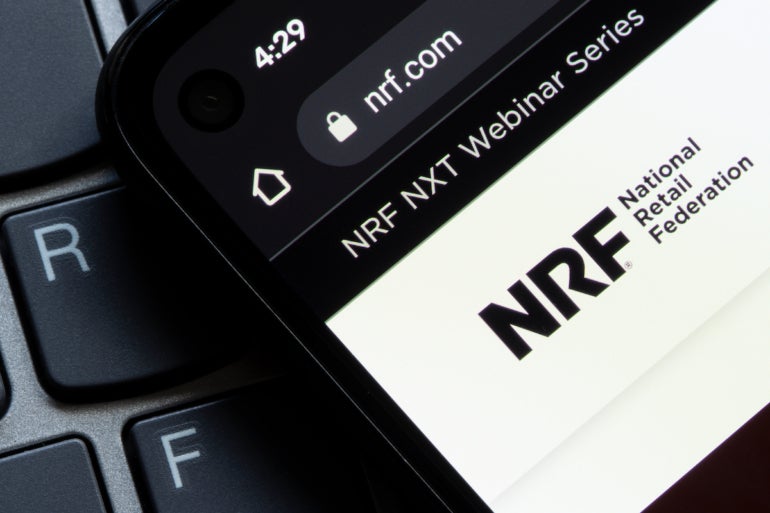
Supply chain solutions, seamless customer experiences and sustainability took pride of place at the National Retail Federation trade show this month in New York City. From tentpole software providers like Google and Amazon Web Services to startups and critical partners, the show explored how technology is transforming retail today.
This is just a small selection of the new product announcements and organizations that were on hand at NRF 2023. While it isn’t possible for us to list everything at the show, we chose highlights that show larger trends or remarkable technology for this wrap-up.
Jump to:
The state of retail today
According to NRF, 2022 holiday sales grew 5.3% over 2021 to $936.3 billion.
While this is lower than the NRF’s forecast, it was an “impressive annual retail sales and a respectable holiday season despite historic levels of inflation and interest rate hikes to cool the economy,” said NRF President and CEO Matthew Shay. “Consumers shopped in record numbers, and retailers delivered positive holiday experiences to inflation-wary consumers, offering great products at more promotional price levels to fit their stretched budgets.”
Common themes this year included creating seamless customer experiences, smoothing out online shopping, improving sustainability by reducing returns, leveraging 5G and the Internet of Things, and solving continuing supply chain woes that started during the coronavirus pandemic.
IBM predicts 5G will top the list of tech investments for the retail industry in 2023. In a study commissioned by Morning Consult, IBM found that 38% of retail business leaders are planning to invest in 5G over the next year, and 80% of retail business leaders believe investing in 5G will make them more profitable in the long run.
New and proven uses for cloud in retail
Running the increased digitization of customer-facing services such as order kiosks requires a lot of computing power, even in brick-and-mortar stores. Cloud and 5G providers both see this as an area of opportunity. Cloud providers seek to take the hosting work out of retailers’ hands and provide more flexible user experiences in return.
For example, Oracle announced during the show that it’s expanded its retail cloud platform to include a retail payments cloud service podium which accepts debit and credit cards as well as Apple, Google and Samsung Pay. For retailers, it’s designed to smooth out the variable payment processing costs that depend on the processing service provider and card type. This cloud service provides a normalizing layer between the retailer and the payment.
SEE: Hiring Kit: Cloud Engineer (TechRepublic Premium)
How are point-of-sale services changing?
Other flagship organizations like AWS, Microsoft, SAP, Zebra and more were also on hand at the show to promote cloud services.
For example, Aptos, a large retail cloud solution and point-of-sale services provider, spoke about transitioning stores from client-server setups to the cloud. Their mobile- and cloud-native approach to POS is designed in part to address in-store connectivity. Dropped internet connections can be a problem due to inclement weather or simply a challenge because of the physical layout of the store.
As a result, their handheld devices sync to the cloud individually so that only one is likely to go down at the same time. In the case of a signal loss during a transaction, it works in reverse: One device communicates that transaction to every device on the floor. The first device that comes back online will transmit it to the cloud. The idea is to avoid a situation in which the store’s entire inventory of computers goes down at the same time.
“Companies care about the devices in the store, not the server space,” said Nikki Baird, vice president of retail innovation for Aptos. “We don’t want them to have to worry about the storage.”
Many organizations at the show encouraged the idea of unified commerce, also known as omnichannel commerce. Baird pointed out that it takes two sides coming together — commerce and inventory.
“The way we define it, commerce is important, but you really need both sides of the equation,” she said. “You need the inventory where the customer wants it, when they want it and when they’re ready to transact.”
Connectivity and hardware
Other companies are solving connectivity problems in different ways. On the hardware side of things, TechRepublic has explored RFID tagging with Wiliot. While Wiliot’s tags are primarily useful for tracking items through the supply chain, others solve problems related to finding things within the store itself.
Handheld devices, order management systems, Amazon’s ubiquitous automated stores and the other companies which emulate them were common sights at the NRF show floor. Some of these, like SAP’s coffee bar, put a digital sheen on the experience of being a local. SAP provided a tag which would remember a customer’s regular order, thereby speeding up the ordering process and skipping the interaction with a human cashier.
On the hardware side, a few chip announcements stood out. Sony Semiconductor Solutions demonstrated several retail services enabled by AITRIOS, an edge AI sensing program. AITRIOS adds AI smarts to cameras that detect and predict inventory shortages. The AITRIOS platform includes the developer tools, software development kits and development environment to connect it to compatible cameras. We watched Vision Group demonstrate how AITRIOS enables a smart cooler enabled by an app.
SEE: Don’t curb your enthusiasm: Trends and challenges in edge computing (TechRepublic)
Hughes also has some particularly interesting hardware in their new power distribution unit for their SD-WAN services, the Hughes Active Power Edge. It helps keep critical networking equipment stay online.
“We know from our own customer help desk that a device reset is all it takes to resolve the issue in about a third of the calls,” said Dan Rasmussen, senior vice president of the enterprise division at Hughes. “The Active Power Edge automatically completes that crucial step to maintain network uptime seamlessly, saving customers time and costly downtime.”
This proprietary Active Power Edge PDU works with the HughesON suite of managed network services.
Rasmussen tapped into the sentiment of the show with his statement that products like this are intended to work to provide the customer with “optimal management, reliability, scalability and ultimately peace of mind.”
Looking forward to more retail technology in the coming year? See 2023 cybersecurity predictions, tips for data migration and AI predictions in retail.
Source of Article


